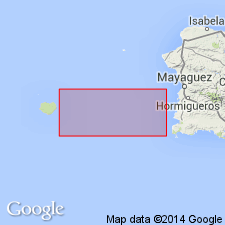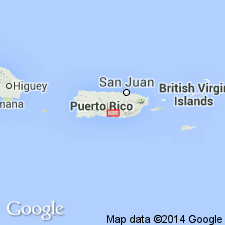
- Usage in publication:
-
- Rio Descalabrado member
- Modifications:
-
- Revised
Summary:
The Jacaguas group is here named. Includes the intertonguing Augustinillo formation and its Collores and Monserrate members and Naranjo formation and its Miramar, Coamo Springs limestone, Rio Descalabrado, and Guayo conglomeratic sandstone members.
Source: GNU records (USGS DDS-6; Reston GNULEX).

- Usage in publication:
-
- Rio Descalabrado Member
- Modifications:
-
- Revised
Summary:
The Jacaguas Group of Pessagno (1960a) is here adopted, as well as the Miramar, Guayo, and Rio Descalabrado Members of the Naranjo Formation of Pessagno (1960a) and the Los Puertos Member of the Naranjo of Pessagno (1960b). The Naranjo Formation and its Coamo Springs Limestone Member and the Augustinillo Formation and its Collores and Monserrate Members are not adopted or discussed. The Raspaldo Formation is here named in the Jacaguas and the Cuevas Limestone of Glover (1961) is assigned to the Jacaguas. Formations are, in ascending order: Miramar, Los Puertos, Raspaldo, disconformity, Cuevas, Guayo, Rio Descalabrado. Unconformably overlies the Coamo Formation; unconformably underlies the Juana Diaz Formation. Age is Late Cretaceous (Maastrichtian) to middle Eocene. Rio Descalabrado is here revised as a formation in the Jacaguas Group and the type section is restricted to include only post-Cuevas rocks similar to those along the Rio Descalabrado. Sharply and conformably overlies the Cuevas Limestone. Age is earliest middle Eocene.
Source: GNU records (USGS DDS-6; Reston GNULEX).

- Usage in publication:
-
- Rio Descalabrado Formation*
- Modifications:
-
- Overview
- AAPG geologic province:
-
- Caribbean region
Summary:
The Rio Descalabrado Formation occurs in southwestern Puerto Rico and consists of dacitic tuff and subordinate mudstone and tuffaceous mudstone. Unit is equivalent to the Monserrate Formation. Maximum estimated thickness is more than 500 meters. The Rio Descalabrado is of early middle Eocene age.
Source: GNU records (USGS DDS-6; Reston GNULEX).
For more information, please contact Nancy Stamm, Geologic Names Committee Secretary.
Asterisk (*) indicates published by U.S. Geological Survey authors.
"No current usage" (†) implies that a name has been abandoned or has fallen into disuse. Former usage and, if known, replacement name given in parentheses ( ).
Slash (/) indicates name conflicts with nomenclatural guidelines (CSN, 1933; ACSN, 1961, 1970; NACSN, 1983, 2005, 2021). May be explained within brackets ([ ]).

